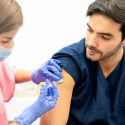What are substance use disorders and how common are they?

Substance use disorders (SUDs) are clinical conditions that involve a “pattern” of substance use that often causes or worsens medical or psychiatric conditions. Many studies and surveys show that SUDs cause suffering and problems for the affected individual, the individual’s family members, and society. These include physical health, mental health, family, employment, legal, and financial problems.
According to the Substance Abuse and Mental Health Services Administration (SAMHSA), about 8 percent of the U.S. population—over 20 million individuals—have a substance use disorder. Although any substance can contribute to a SUD, the most common disorders involve nicotine, alcohol, cannabis, opioids, or stimulants. Many individuals have more than one SUD.
A SUD involves a combination of these 11 symptoms occurring within the past year:
- Loses control and uses too much of a substance or
uses a substance for longer than intended. - Attempts to stop using, but these attempts do
not last. - Has strong desires or cravings for alcohol and/or
drugs. - Experiences withdrawal symptoms, like nausea or
excessive sweating, when substance use is reduced or stopped. - Uses regularly to avoid withdrawal symptoms.
- Needs more of the substance to get the desired effect
over time or gets high more easily (tolerance changes). - Spends much time getting, using, or recovering
from the effects of substances. - Fails to fulfill work, school, or home
obligations. - Continues to use substances despite social or
relationship problems. - Continues to use substances despite physical or
psychological problems. - Reduces or stops important activities due to
substance use. - Uses in situations in which it is physically
hazardous, such as driving a vehicle.
A SUD can be mild (two to three symptoms), moderate (four to five symptoms), or severe (six or more symptoms) and can be life threatening. However, even a single episode of use can have a serious, negative outcome even if the person does not meet the criteria for a disorder. For example, we all know of instances in which fatal accidents have occurred as a result of someone driving under the influence of alcohol or drugs.
What are the different paths to recovery from a substance use disorder?
The good news is that there are many paths to recovery from SUDs even though only about one in 10 gets professional help in a rehabilitation, medical management, or ambulatory treatment program, or receives medications for SUDs involving alcohol, opioids, or nicotine.
The key to success is sticking with professional treatment long enough, especially for more severe SUDs. It is not unusual for individuals with more severe SUDs to engage in multiple episodes and types of treatment before they sustain long-term recovery.
What mutual support programs are available?
Many people with SUDs benefit from mutual support programs such as AA, NA, Cocaine Anonymous, or other 12-step programs. Other mutual support programs include—but are not limited to—Alcoholics Victorious, Women for Sobriety, SMART recovery, and others. Meetings may be attended in person or, in some instances, online. Some organizations such as AA and NA have programs for families and significant others, such as Al-Anon, Ala-teen, or Nar-Anon.
Do people with SUDs get better?
Studies and surveys show that a large number of individuals with SUDs do improve their lives considerably. Many have severe SUDs yet, with continued involvement in treatment or community recovery programs, they can make incredible strides to improve their lives.
Those with less severe SUDs may even succeed in quitting on their own. Some use the help and support of their family, friends, church, synagogue, or community. Others rely on their own resources to quit or reduce their substance use to the point where using does not cause problems. However, it is important to note that those with more severe SUDs often need help from professionals and peers in mutual support programs to engage in recovery and make positive changes in their lives.
For more information on how and where to receive support, visit our website or call SAMHSA’s National Helpline at 1-800-662-HELP (4357).
References
Daley DC & Douaihy A (2019). Recovery from Substance Use Disorder, 3rd edition. New York: Oxford University Press.
Kelly JF et al (2017). Prevalence pathways and predictors of recovery from drug and alcohol related problems in the U.S. population. Drug and Alcohol Dependence, 181: 162-169.
Laudet A (2013). Life in Recovery: Report on the Survey Findings. Washington, DC: Faces and Voices of Recovery.
National Institute on Drug Abuse (NIDA, 2012). Principles of Addiction Treatment: A Research-Based Guide, 3rd ed. Rockville, MD: NIDA.



